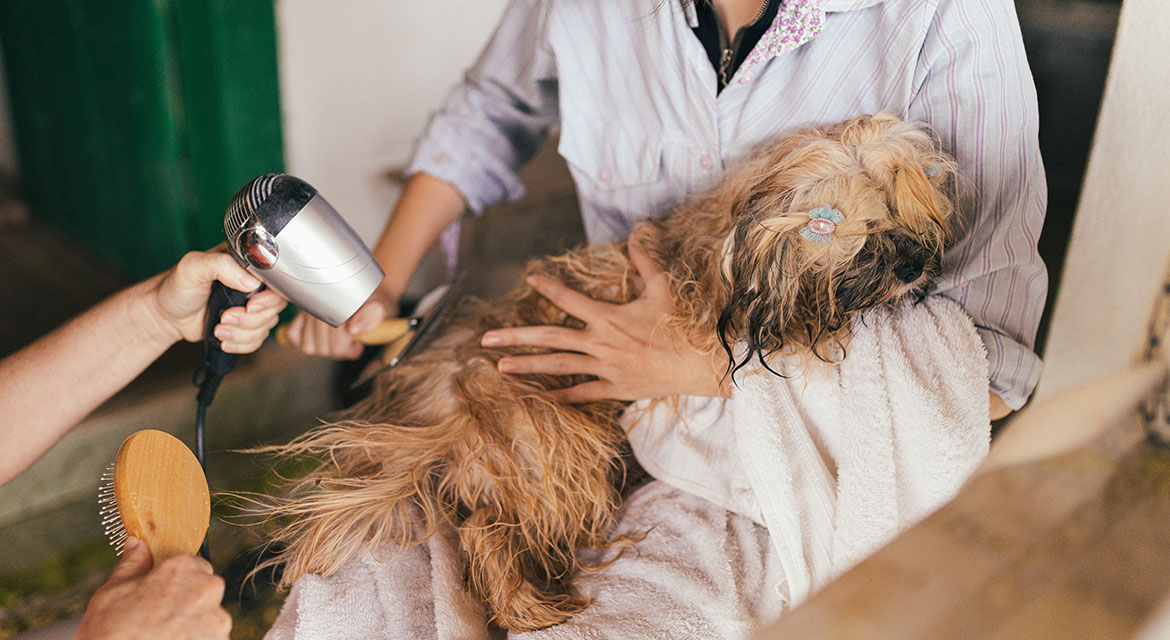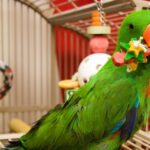 4 May
4 MayHow to Groom a Puppy: The Complete Guide to Starting Good Habits Early
Table of Contents
Learning how to groom a puppy properly is one of the most important responsibilities you’ll face as a new pet parent. Early grooming not only maintains your puppy’s hygiene and health but also establishes positive lifelong habits through short, reward-based sessions. When you know how to groom a puppy correctly, you’re setting the foundation for years of stress-free care routines that benefit both you and your furry friend.
This comprehensive guide covers everything you need to know about how to groom a puppy – from selecting the right tools to handling specific grooming tasks and creating a positive experience that your puppy will actually enjoy.
Why Learning How to Groom a Puppy Matters
Grooming is far more than just keeping your puppy looking cute (though that’s certainly a bonus). Regular grooming sessions:
- Remove dirt, debris, and loose hair that can cause skin irritation and infections
- Distribute natural oils throughout the coat for healthy shine
- Allow early detection of potential health issues like skin problems, lumps, or parasites
- Create bonding opportunities that strengthen your relationship
- Socialize your puppy to handling that will be necessary throughout their life
When you learn how to groom a puppy properly from the beginning, you prevent the development of fear or resistance that can make grooming difficult as your dog matures. The investment you make now in teaching your puppy to enjoy grooming will pay dividends for years to come.
Essential Supplies: What You Need to Groom a Puppy
Before you begin learning how to groom a puppy, gathering the right tools is crucial. Quality matters when it comes to grooming supplies – the right equipment makes the process smoother for both you and your puppy.
Basic Grooming Tools
For Coat Care:
- Soft-bristle brush: Perfect for short-haired breeds and gentle introduction to brushing
- Slicker brush: Ideal for longer coats to prevent mats and tangles
- Pin brush: Works well for medium to long coats
- Dematting comb: Essential for removing knots in long-haired puppies
- Grooming mitt: A gentle introduction for very young puppies
For Nail, Ear, and Dental Care:
- Puppy-sized nail clippers: Smaller clippers are more precise and less intimidating
- Styptic powder: To stop bleeding if you accidentally cut the quick
- Puppy-safe ear cleaning solution: Formulated specifically for delicate puppy ears
- Cotton balls or pads: For gentle ear cleaning
- Puppy toothbrush and enzymatic toothpaste: Never use human toothpaste
For Bathing:
- Puppy-formulated shampoo: pH-balanced and gentle on sensitive skin
- Non-slip bath mat: Provides security during bath time
- Absorbent towels: Microfiber towels work particularly well
- Wide-toothed comb: For pre-bath detangling
- Spray attachment for faucet: Creates gentle water pressure
Safety and Quality Considerations
When selecting tools to groom a puppy, always prioritize quality and safety:
- Choose rounded tips: Avoid sharp edges on combs and scissors that could injure delicate skin
- Select ergonomic designs: Tools that fit comfortably in your hand reduce the risk of accidents
- Invest in durable materials: High-quality stainless steel and non-toxic plastics last longer and clean better
- Consider your puppy’s specific coat type: Different breeds require different tools
- Read reviews: Other pet parents’ experiences can guide your choices
Remember that bargain-basement grooming supplies often use low-grade materials that can break, pinch, or irritate your puppy’s skin. A slightly higher initial investment in quality tools will save money (and stress) in the long run.
Creating the Ideal Environment to Groom a Puppy
Where and how you set up your grooming space significantly impacts how your puppy responds to the experience. The right environment helps you both feel comfortable and confident as you learn how to groom a puppy.
Setting Up a Safe Grooming Space
- Choose a quiet location: Select an area away from household traffic and noise that might startle your puppy
- Ensure good lighting: You need to see clearly to groom safely
- Use a non-slip surface: A rubber mat or towel on a table or countertop prevents slipping
- Control temperature: Make sure the room is comfortably warm, especially for bathing
- Minimize distractions: Turn off loud appliances and consider playing soft, calming music
Organizing Your Supplies
- Keep tools within reach: Arrange supplies in order of use to maintain a smooth workflow
- Use a caddy or tray: Contains everything and prevents items from rolling away
- Secure potentially dangerous items: Keep scissors and small objects where curious puppies can’t reach them
- Prepare treats in advance: Have small, high-value rewards ready to dispense
- Have clean towels available: Multiple towels help manage bath time more effectively
Maintaining Cleanliness and Hygiene
Proper cleaning of your grooming tools not only extends their life but also protects your puppy’s health:
- Rinse brushes thoroughly: Remove hair and debris after each use
- Sanitize nail clippers and scissors: Wipe with alcohol between sessions
- Launder towels promptly: Prevent mildew growth
- Dry tools completely: Moisture can lead to rust or bacterial growth
- Store in a clean, dry place: A dedicated container keeps everything organized and protected
Preparing Your Puppy for Their First Grooming Experience
Success in learning how to groom a puppy starts before you ever pick up a brush. Preparation and introductory steps create a foundation for positive grooming experiences.
Gradual Introduction to Grooming
Puppies who are introduced to grooming concepts gradually and positively are much more likely to accept and even enjoy grooming throughout their lives:
- Start with simple handling: In the first weeks, spend time gently touching your puppy’s paws, ears, tail, and face while offering praise
- Introduce tools slowly: Let your puppy investigate brushes and other equipment without pressure
- Create positive associations: Pair brief touches of grooming tools with treats and praise
- Practice the positions: Help your puppy get comfortable being held in different positions before actual grooming begins
- Use gentle restraint techniques: Teach your puppy to accept being held steady with minimal stress
Timing and Frequency
Knowing when to start grooming your puppy and how often to do it sets realistic expectations:
- Begin between 8-12 weeks: Once puppies have settled into their new home
- Schedule short sessions: Keep initial grooming to 5-10 minutes maximum
- Choose the right moment: Groom when your puppy is naturally calm, perhaps after play or a meal
- Establish a routine: Regular, predictable grooming helps puppies feel secure
- Adjust frequency based on coat type: Long-haired puppies need more frequent attention
For specific frequency guidelines on how to groom a puppy:
- Short-haired breeds: Brushing every 1-2 weeks, bathing every 6-8 weeks
- Medium-haired breeds: Brushing weekly, bathing every 4-6 weeks
- Long-haired breeds: Brushing 2-3 times weekly, bathing every 4-6 weeks
- Double-coated breeds: Brushing 2-3 times weekly, bathing every 8-10 weeks
Recognizing and Managing Stress
Even with perfect preparation, some puppies will show signs of stress during grooming. Learning how to groom a puppy includes recognizing these signals:
Signs of Stress to Watch For:
- Whale eye (showing whites of the eyes)
- Excessive yawning or lip licking
- Trembling or shaking
- Panting when not hot
- Attempts to escape or hide
- Whining or growling
- Freezing or extreme stillness
Managing Stress Effectively:
- Take immediate breaks: If stress signs appear, pause and let your puppy relax
- Use calming techniques: Speak softly and maintain a relaxed posture yourself
- Never punish fear responses: This only confirms grooming as something negative
- Adjust your approach: Try a different tool or technique if one causes consistent stress
- End on a positive note: Always finish before your puppy becomes overwhelmed
Step-by-Step Guide: How to Groom a Puppy
Now that you’ve prepared yourself and your puppy, it’s time to learn the specific techniques for each aspect of puppy grooming.
Brushing Your Puppy’s Coat
Brushing is often the first grooming skill to master when learning how to groom a puppy:
- Start with gentle strokes: Use the brush your puppy is most comfortable with
- Brush in the direction of hair growth: Begin at the neck and work toward the tail
- Use proper technique for coat type:
- Short coats: Use a rubber curry brush or grooming mitt in circular motions
- Medium coats: Use a slicker brush followed by a bristle brush
- Long coats: Begin with a pin brush to remove tangles, then finish with a bristle brush
- Double coats: Use an undercoat rake followed by a slicker brush
- Pay special attention to tangle-prone areas: Behind ears, under legs, and tail area
- Reward frequently: Give treats for calm behavior, especially in the beginning
Pro Tip: For puppies with longer coats, mist the coat lightly with water or a detangling spray before brushing to prevent static and make the process more comfortable.
Bathing Your Puppy
Bathing is a crucial skill when learning how to groom a puppy, but it can also be one of the most challenging for both of you:
- Prepare the bath area: Gather all supplies and run lukewarm water before bringing your puppy in
- Protect ears: Place a cotton ball just at the opening of each ear (remove after bath)
- Use a non-slip mat: This provides security and prevents falls
- Pre-brush thoroughly: Remove tangles before they become waterlogged mats
- Wet coat thoroughly: Use a handheld sprayer or cup to wet your puppy completely except for the head
- Apply puppy shampoo: Start at the neck and work down, using a small amount diluted according to directions
- Massage gently: Work the shampoo in with circular motions of your fingertips
- Clean face carefully: Use a damp washcloth without shampoo around eyes and ears
- Rinse completely: Residual shampoo can cause skin irritation
- Towel dry first: Remove excess water before introducing a dryer
- Use low heat: If using a dryer, keep it on the lowest setting and at a distance
- Brush while drying: This prevents tangles and speeds the process
Nail Trimming
Many puppies (and owners) find nail trimming stressful, but it’s an essential part of learning how to groom a puppy:
- Examine the nail structure: Identify the quick (pink area with blood vessels)
- Hold paw firmly but gently: Support the paw while extending one nail at a time
- Trim just the tip: Cut at a 45-degree angle below the quick
- Use sharp clippers: Dull clippers can crush and split nails
- Have styptic powder ready: In case you accidentally cut too short
- Take breaks between paws: This reduces stress for sensitive puppies
- Consider a nail grinder: Some puppies prefer this to clippers
Pro Tip: If your puppy has dark nails where you can’t see the quick, trim very small amounts at a time, or shine a flashlight behind the nail to help identify the quick.
Ear Cleaning
Clean ears prevent infections and discomfort:
- Inspect first: Look for redness, discharge, or unusual odor that might indicate infection
- Apply cleaner properly: Put a few drops of puppy-safe ear cleaner into the ear canal
- Massage gently: Rub the base of the ear for 15-30 seconds to loosen debris
- Allow head shaking: Let your puppy shake their head to bring debris to the outer ear
- Wipe outer ear only: Use cotton balls or soft cloth to clean what you can see
- Never insert anything: Cotton swabs or other objects can damage the ear canal
Eye Care
Keeping the eye area clean prevents irritation:
- Use separate wipes: Clean each eye with a fresh cloth or wipe
- Wipe from inner to outer corner: This avoids spreading potential infection
- Be gentle around tear stains: For breeds prone to tear staining, clean daily
- Watch for signs of irritation: Redness, squinting, or discharge may indicate a problem
Dental Care
Starting dental care early is vital when learning how to groom a puppy:
- Choose puppy-specific products: Use enzymatic toothpaste formulated for dogs
- Introduce gradually: Let your puppy taste the toothpaste first
- Use gentle technique: Lift the lip and brush in circular motions
- Focus on outer surfaces: Most plaque accumulates on the cheek side of teeth
- Keep sessions brief: Even 30 seconds of brushing helps in the beginning
- Aim for consistency: Daily brushing is ideal
Breed-Specific Considerations When Learning How to Groom a Puppy
Different breeds have unique grooming needs based on their coat type and structure:
Short-Haired Breeds (Beagles, Boxers, Dachshunds)
- Focus on: Weekly brushing with rubber curry brush, occasional baths
- Special concerns: May shed more than expected; regular brushing helps control shedding
Medium-Haired Breeds (Australian Shepherds, Border Collies)
- Focus on: Preventing mats behind ears and in feathering
- Special concerns: Seasonal shedding requires more frequent brushing
Long-Haired Breeds (Shih Tzus, Maltese, Yorkshire Terriers)
- Focus on: Daily brushing to prevent painful mats and tangles
- Special concerns: May need professional trimming every 4-6 weeks
Double-Coated Breeds (Huskies, Samoyeds, German Shepherds)
- Focus on: Thorough brushing with undercoat rake during shedding seasons
- Special concerns: Never shave a double coat; it damages the coat’s natural insulation
Curly-Haired Breeds (Poodles, Bichon Frises)
- Focus on: Regular brushing to prevent tight mats close to skin
- Special concerns: Need professional grooming every 4-8 weeks to maintain coat health
Common Challenges and Solutions When Learning How to Groom a Puppy
Even with perfect preparation, you’ll likely encounter some challenges as you learn how to groom a puppy:
Challenge: Puppy Won’t Stay Still
Solutions:
- Use a grooming loop or have a helper gently hold your puppy
- Break the session into smaller, more manageable parts
- Schedule grooming when your puppy is naturally calmer
- Practice “stay” command during non-grooming times
Challenge: Fear of Clippers or Dryers
Solutions:
- Desensitize gradually by turning tools on at a distance
- Use treats while the sound is playing to create positive associations
- Try quieter alternatives like silent clippers or towel drying
- Play recordings of grooming sounds at low volume during playtime
Challenge: Sensitive Areas
Solutions:
- Build tolerance by touching sensitive areas briefly during cuddle time
- Use a high-value treat reserved only for difficult grooming tasks
- Try different tools or techniques that might be more comfortable
- Consider professional help for particularly sensitive areas
Challenge: Matted Coat
Solutions:
- Never pull or cut mats close to the skin
- Use a dematting tool designed to safely work through tangles
- Apply detangling spray and work through mats with fingers first
- For severe matting, consult a professional groomer
When to Seek Professional Help
While learning how to groom a puppy at home is valuable, sometimes professional assistance is necessary:
Consider Professional Grooming When:
- Your puppy has severe matting that can’t be safely removed at home
- You notice skin issues like redness, bumps, or excessive itching
- Your puppy shows extreme stress despite gradual introduction to grooming
- Breed-specific cuts are desired (especially for poodles, terriers, etc.)
- You need guidance on proper techniques specific to your puppy’s coat type
Finding a Puppy-Friendly Groomer:
- Ask for recommendations: Consult your veterinarian or puppy training instructor
- Visit without your puppy first: Observe the environment and ask about puppy policies
- Check qualifications: Look for certification and experience with puppies
- Discuss approach: Ensure they use positive, force-free methods
- Start with a basic service: Begin with just a bath or brush-out before a full groom
Creating a Lifelong Positive Grooming Routine
The ultimate goal in learning how to groom a puppy is establishing habits that last a lifetime:
Consistency is Key
- Set a regular schedule: Mark grooming days on your calendar
- Create a pre-grooming routine: A specific toy or treat signals grooming time
- Use consistent commands: Words like “brush” or “paw” help your puppy understand expectations
- Maintain the same location: Familiarity reduces anxiety
Making Grooming Fun
- Play grooming games: Hide treats in towels or create a treasure hunt after grooming
- Use special toys: Reserve certain toys only for grooming time
- Incorporate massage: Turn parts of grooming into a relaxing massage
- Celebrate success: Have a special play session after grooming is complete
Monitoring Health During Grooming
Use grooming time as an opportunity to check your puppy’s overall health:
- Skin condition: Look for redness, flaking, bumps, or parasites
- Coat quality: Note any changes in texture or excessive shedding
- Ear health: Check for odor, discharge, or sensitivity
- Eye clarity: Watch for redness, cloudiness, or discharge
- Weight and body condition: Feel for ribs and monitor overall body shape
Conclusion: Mastering How to Groom a Puppy
Learning how to groom a puppy properly is one of the greatest gifts you can give your new four-legged family member. Through patience, consistency, and positive reinforcement, you transform potentially stressful experiences into bonding opportunities that support your puppy’s physical and emotional wellbeing.
Remember that each puppy is unique, and what works for one may not work for another. Be willing to adapt your approach as you discover your puppy’s preferences and sensitivities. The time you invest now in teaching your puppy to enjoy grooming will save countless hours of struggle later and contribute to a harmonious relationship built on trust and understanding.
With the right tools, techniques, and mindset, you’ll master how to groom a puppy in ways that keep them healthy, comfortable, and looking their adorable best for years to come.
FAQ: How to Groom a Puppy
Q: When should I start grooming my new puppy? A: Begin handling and gentle introduction to grooming tools as soon as you bring your puppy home (usually 8-10 weeks), but wait until after their initial vaccinations for the first full bath.
Q: How often should I bathe my puppy? A: Most puppies need bathing every 4-8 weeks, depending on coat type and activity level. Over-bathing can strip natural oils and cause skin problems.
Q: What should I do if I accidentally cut my puppy’s nail too short? A: Apply styptic powder or cornstarch with gentle pressure until bleeding stops. Contact your vet if bleeding continues for more than a few minutes.
Q: My puppy hates having their paws touched. How can I trim their nails? A: Start by desensitizing through brief touches paired with high-value treats. Gradually increase duration and pressure until your puppy accepts paw handling comfortably.
Q: Is it better to use scissors or clippers for trimming the hair around my puppy’s face? A: For safety, rounded-tip scissors are best for facial trimming. Always keep scissors pointing away from your puppy’s eyes and work slowly.
Q: How do I clean my puppy’s tear stains? A: Use a damp cloth with warm water to gently wipe tear stains daily. For persistent staining, consult your veterinarian as it may indicate allergies or eye irritation.
Q: Should I use conditioner when bathing my puppy? A: Conditioner isn’t usually necessary for puppies unless they have a long coat prone to tangling. If used, choose a product specifically formulated for puppies.
Q: My puppy gets extremely anxious during grooming. Should I sedate them? A: Never sedate your puppy without veterinary guidance. Instead, focus on positive reinforcement, shorter sessions, and gradual desensitization.
Q: How do I remove a tick I find while grooming my puppy? A: Use fine-tipped tweezers to grasp the tick as close to the skin as possible and pull upward with steady pressure. Clean the area afterward and save the tick in alcohol for identification if your puppy shows signs of illness.
Q: Can I use human shampoo on my puppy in an emergency? A: It’s best to avoid human shampoo as it has the wrong pH balance for puppy skin. In a true emergency, a mild, unscented baby shampoo is the least harmful alternative, but use it only once before purchasing proper puppy shampoo.
You May Also Like :
How to Stop Dog Barking: The Complete Guide to a Quieter, Happier Pet
Comprehensive Guide to Interactive Cat Toys: Keeping Indoor Cats Happy and Healthy
Dog Grooming at Home: The Complete Guide for Dog Owners
10 Essential Dog Training Tips Every New Puppy Owner Should Know
How to Take Care of a Pet: Essential Guide to Responsible Pet Ownership
The Ultimate Guide to Cat Playtime: Why Play Is Essential for Your Feline’s Health and Happiness
How to Successfully Work from Home with Pets: A Comprehensive Guide
The Mental Health Benefits of Having a Dog: What Every Pet Owner Should Know
How to Groom a Puppy for the First Time: Step-by-Step Guide
Quick Solutions for Daily Pet Care: Simple Strategies for a Happier Pet and Easier Routine




